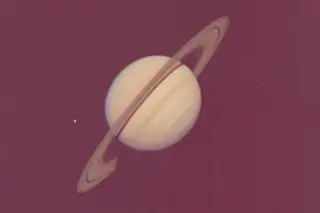This story appeared in the September/October 2020 issue as part of Discover magazine’s 40th anniversary coverage. We hope you’ll subscribe to Discover and help support our next 40 years of delivering science that matters.
Since touring Jupiter and its myriad moons last year and sending back spectacular pictures, Voyager 1 has been cruising through the void toward a fall rendezvous with Saturn. On August 22, [1980], Jet Propulsion Laboratory scientists roused the slumbering spacecraft to begin observing its next target full time. Two days later, while still 66 million miles away from Saturn, it transmitted the best picture yet taken of the ringed planet and three of its nine confirmed moons. Reported a JPL spokesman: “Voyager has been working literally like a clock.”
The story as it originally appeared in the October 1980 issue of Discover.
On November 12 the instrument-laden wanderer will dive under Saturn’s rings and swoop to ...
















